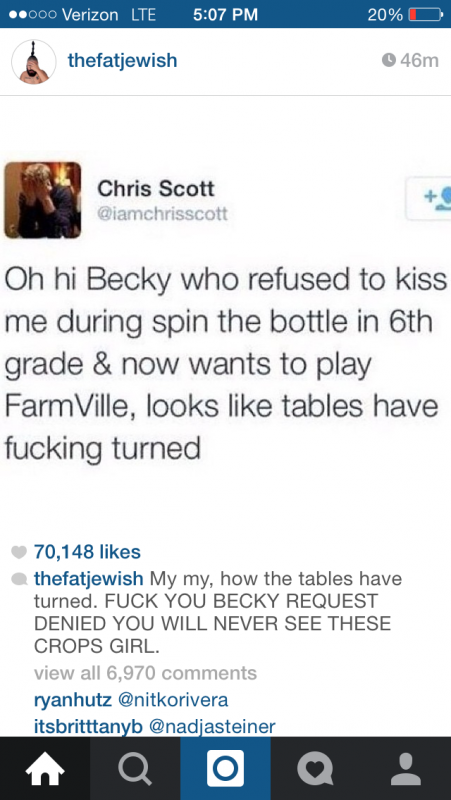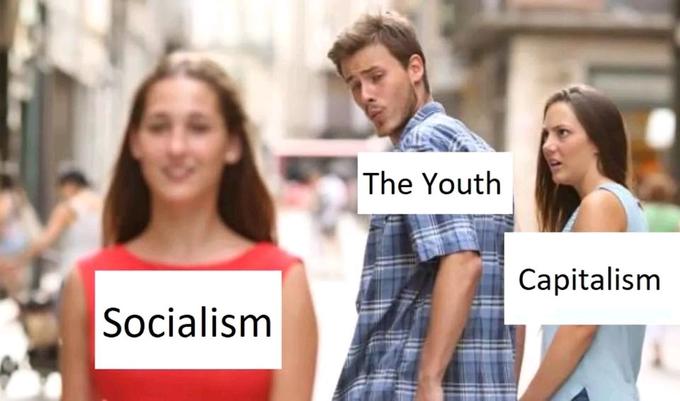The Emergence of Cultural Production Through Memes
Posted on October 26, 2018meme
/mēm/
noun
noun: meme; plural noun: memes
- an element of a culture or system of behavior that may be considered to be passed from one individual to another by non-genetic means, especially imitation.
- a humorous image, video, piece of text, etc., that is copied (often with slight variations) and spread rapidly by Internet users.

TFW You Accidentally Produce Culture
The screenshot above is from 2015. The Fat Jew, a now-famous Instagram celebrity, repackaged content generated by a semi-anonymous Twitter user, and I thought it was brilliant. The tweet-turned-image typified the experience of my generation — the confrontation of ghosts from years past extending a perfunctory olive branch in the form of an invitation to start anew at a virtual farm. Though willfully humorous, the commentary on the everyday creates a sense of belonging to a particular epoch, one in which we can relate to one another by appropriating an extant text or image and tweaking it to reflect our own attitudes. From the vantage point of the individual, meme creation is an expression of the self; however, from further back we can begin to see a macrobehavior of cultural production. While memes continue to evolve, their makeup ranging from clippings of political diatribes to photos of baby animals making faces, their collective output is consistent. Steven Johnson explains this phenomenon of emergence as “self-organization… of disparate agents that unwittingly create a higher-level order.”1 Through the reactions of individual agents to environmental stimuli, meme culture has emerged as a litmus test of what matters to an entire milieu.
Emergence, or Something Like It
I cannot declare with complete confidence that meme culture is a consummate example of an emergent system. In her study of ant colonies, Biologist Deborah Gordon argues that emergent systems can be characterized by “individuals who are unable to assess the global situation [and] still work together in a coordinated way… [managing] to do it using only local information.”2 By this criteria, meme culture does not fit the bill—after all, the propulsion behind the creation of memes relies on access to global information. However, I posit that meme culture operates on the five principles of emergence proposed by Johnson.
The first principle is more is different — more proof points enable us to assume individual behavior is indicative of global behavior. In the case of memes, one to a few appropriations of a photo does help us glean an understanding of the culture in which it exists; however, as the photo is regenerated, its free agent appropriators responding to new current events, a cultural commentary emerges. Take the Distracted Boyfriend meme, for example. The stock photo’s concomitant text has been altered countless times, each instance a representation of a more macro interest.


If a person were dropped into today’s society with no prior knowledge about its values, politics, or humor, my guess is that person might be able to navigate our cultural identity fairly well using just the Distracted Boyfriend memes as their north star.
Ignorance is useful, Johnson’s second principle of emergence, is a little tougher to connect to meme culture, but a link can still be made. Human intelligence is an unignorable feature in the creation of memes; however, because of the decentralized structure of meme culture, each creator is motivated by self-interest (in this instance meaning self-amusement), expressing what delights them. Individual meme creators do not set out to act as cultural producers, rather, that behavior is a byproduct of myopic, autonomous behavior. We can better understand the relationship between individualistic activity (ignorance) and macrobehavior by considering Donella Meadows’ definition of hierarchies. “Hierarchies,” she says, “are brilliant systems inventions, not only because they give a system stability and resilience, but also because they reduce the amount of information that any part of the system has to keep track of.”3 By Meadows’ standards, the self-interest of each creator is actually what enables cultural commentary to emerge.
Additionally, the internet enables a unique degree of both interconnectedness and anonymity, encouraging random encounters—Johnson’s third principle of emergence—among meme creators. Its boundless format liberates meme creators from any predetermined rules for production and appropriation, allowing an agent to assign value to other memes they come across according to their own preferences. Without guidance, the creator can browse at their leisure, gaining exposure to other agents’ products by happenstance. In turn, these encounters expose patterns, the fourth principle of emergence, all by paying attention to neighbor meme creators, the fifth principle of emergence.
Viewing the Distracted Boyfriend series as a microcosm for all meme generation allows us to observe how “global behavior outlasts any of its component parts.”4 On August 19 the Distracted Boyfriend meme was annotated with capitalism, youth, and socialism, socialism being the twinkle in the eye of the youth, and garnered 31,200 likes in 24 hours on Reddit.5 The photo had only been in circulation for 7 months, through several iterations, gaining more momentum each run. While its original iteration has been abandoned, forgotten as discourse evolved, Distracted Boyfriend continues to be a birth site of cultural production. Who knew that a stock photo could say so much?

ESF
Sources:
- Johnson, Steven. Emergence: The Connected Lives of Ants, Brains, Cities, and Software. Scribner, 2004, pp. 21.
- Johnson, Steven. Emergence: The Connected Lives of Ants, Brains, Cities, and Software. Scribner, 2004, pp. 74.
- Wright, Diana, and Donella H. Meadows. Thinking in Systems : A Primer, Taylor & Francis Group, 2009, pp. 82.
- Johnson, Steven. Emergence: The Connected Lives of Ants, Brains, Cities, and Software. Scribner, 2004, pp. 82.
- “Distracted Boyfriend.” Know Your Meme, 24 Oct. 2018, knowyourmeme.com/memes/distracted-boyfriend.